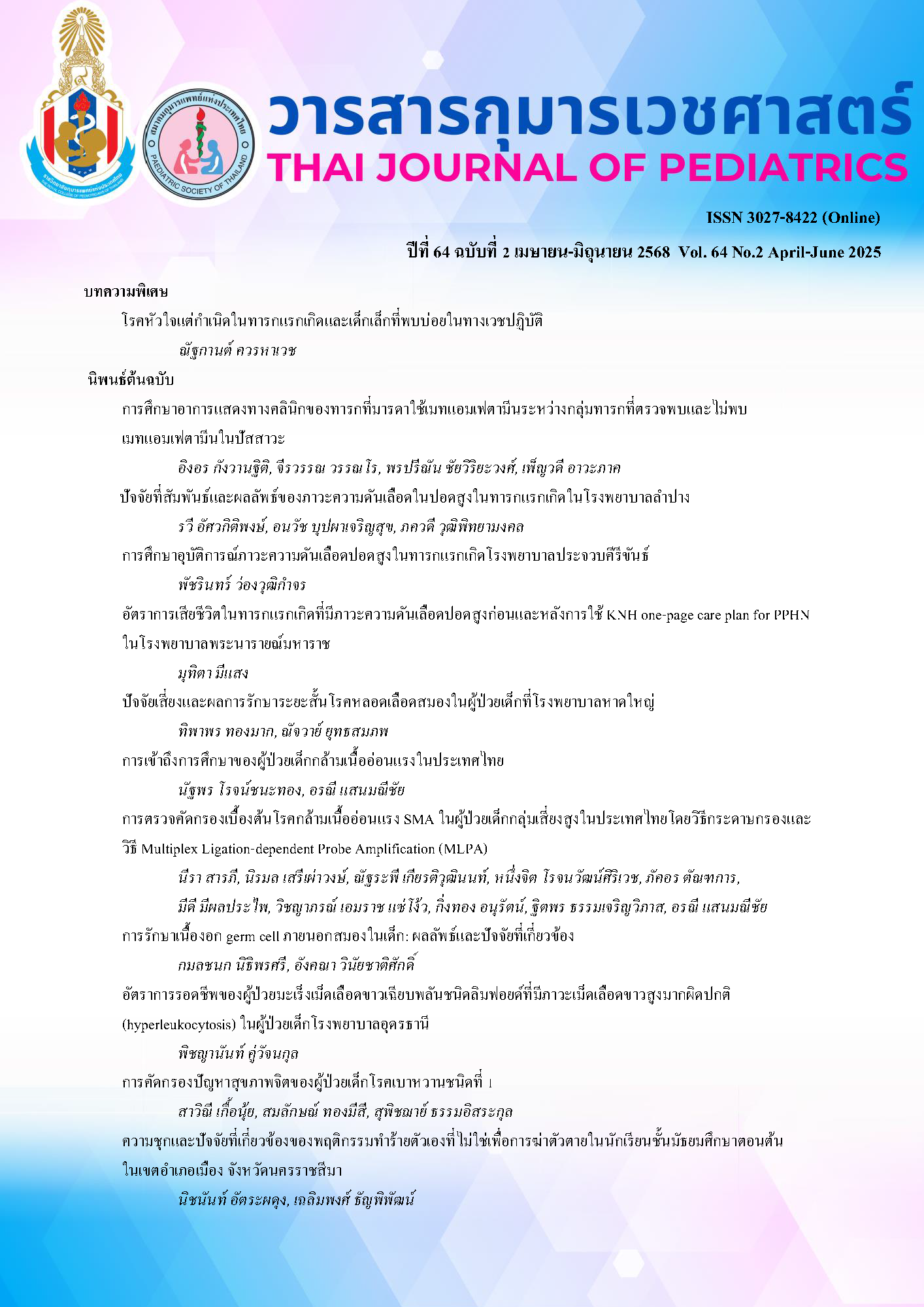ความชุกและปัจจัยที่เกี่ยวข้องของพฤติกรรมทำร้ายตัวเองที่ไม่ใช่เพื่อการฆ่าตัวตาย ในนักเรียนชั้นมัธยมศึกษาตอนต้น ในเขตอำเภอเมือง จังหวัดนครราชสีมา
คำสำคัญ:
NSSI, Suicide, Adolescent, Depression, Self injuryบทคัดย่อ
ความเป็นมา: พฤติกรรมทำร้ายตัวเองที่ไม่ใช่เพื่อการฆ่าตัวตายเป็นปัญหาที่พบมากขึ้นทั่วโลกส่งผลกระทบต่อร่างกาย จิตใจ และผลกระทบเชิงลบต่อความสัมพันธ์ระยะยาว ปัจจุบันการศึกษาในประเทศไทยยังมีจำนวนจำกัด
วัตถุประสงค์: เพื่อศึกษาความชุกของพฤติกรรมทำร้ายตัวเองที่ไม่ใช่เพื่อการฆ่าตัวตายและปัจจัยที่เกี่ยวข้องในนักเรียนชั้นมัธยมศึกษาตอนต้น อำเภอเมือง จังหวัดนครราชสีมา
วิธีการศึกษา: การศึกษาเชิงพรรณนา เก็บข้อมูลโดยใช้การสุ่มตัวอย่างแบบชั้นภูมิในนักเรียนชั้นมัธยมศึกษาตอนต้น อายุ 11 - 15 ปี ในโรงเรียนสังกัดสำนักงานเขตพื้นที่การศึกษามัธยมศึกษา อำเภอเมือง จังหวัดนครราชสีมา ระหว่าง 1 พฤษภาคม - ธันวาคม พ.ศ. 2566 เก็บข้อมูลทั่วไป แบบสอบถาม The Brief NSSI Assessment Tool, Patient health questionnaire for adolescent (PHQ-A), Resilience inventory 9 (RI-9), revised UCLA loneliness scale 6 (RULS-6) ฉบับภาษาไทย วิเคราะห์ข้อมูลโดยใช้สถิติเชิงพรรณนา
ผลการศึกษา: นักเรียนจำนวน 1,388 คน พบว่า 436 คน (ร้อยละ 31) มีพฤติกรรมการทำร้ายตนเอง ที่ไม่ใช่เพื่อการฆ่าตัวตาย ปัจจัยที่สัมพันธ์อย่างมีนัยสำคัญกับพฤติกรรมดังกล่าวคือ เพศหญิง การเคยถูกล้อแกล้งรังแก การเลี้ยงดูแบบปล่อยปละละเลย ภาวะซึมเศร้า ความรู้สึกโดดเดี่ยวที่สูง และการมีความสามารถในการปรับตัวน้อย
สรุป: พฤติกรรมการทำร้ายตนเองที่ไม่ใช่เพื่อการฆ่าตัวตาพบได้สูงในนักเรียนชั้นมัธยมศึกษาตอนต้น อำเภอเมือง จังหวัดนครราชสีมา และสัมพันธ์กับปัจจัยหลายด้านโดยเฉพาะอาการซึมเศร้า
Downloads
เอกสารอ้างอิง
American psychiatric association. Diagnostic and statistical manual of mental disorders, fifth edition, text revision (DSM-5-TR). Arlington,.VA: American psychiatric association. 2022:923-6.
Hawton K, O’Connor RC, Saunders KE. Suicidal behavior and self-harm. In: Thapar A, Pine DS, Leckman JF, Scott S, Snowling MJ, Taylor EA, eds. Rutters child and adolescent psychiatry. Chichester: John Wiley & Sons, Ltd. 2015:893-910.
Lim KS, Wong CH, McIntyre RS, Wang J, Zhang Z, Tran B, et al. Global lifetime and 12-month prevalence of suicidal behavior, deliberate self-harm and non-suicidal self-injury in children and adolescents between 1989 and 2018: A meta-analysis. Int J Environ Res Public Health. 2019; 16:4581.
Giletta M, Scholte RH, Engels RC, Ciairano S, Prinstein MJ. Adolescent non-suicidal self-injury: A cross-national study of community samples from Italy, the Netherlands and the United States. Psychiatry Res. 2012;197:66–72.
Jeong JY, Kim DH. Gender differences in the prevalence of and factors related to non-suicidal self-injury among middle and high school students in south korea. Int J Environ Res Public Health. 2021;18:5965.
Garisch JA, Wilson MS. Prevalence, correlates, and prospective predictors of non-suicidal self-injury among New Zealand adolescents: Cross-sectional and longitudinal survey data. Child Adolesc Psychiatry Ment Health. 2015;9:1-11.
เวธนี อุบลศรี, ศิริรัตน์ อุฬารตินนท์. การศึกษารูปแบบและลักษณะของพฤติกรรมการทำร้ายตนเองที่ไม่ใช่เพื่อการฆ่าตัวตายในผู้ป่วยวัยรุ่น.วิทยานิพนธ์เพื่อวุฒิบัตรแสดงความรู้ ความชำนาญสาขาจิตเวชศาสตร์เด็กและวัยรุ่น. กรุงเทพฯ: สถาบันสุขภาพเด็กแห่งชาติมหาราชินี. 2564.
Panyawong W, Pavasuthipaisit C, Santitadakul R. Validation of the Thai version of the patient health questionnaire for adolescents (PHQ-A) in adolescent psychiatric patients. Int J Child Dev Ment Health. 2020;8:30-40.
Wongpakaran N, Wongpakaran T, Pinyopornpanish M, Simcharoen S, Suradom C, Varnado P, et al. Development and validation of a 6‐item revised UCLA loneliness scale (RULS‐6) using rasch analysis. Br J Health Psychol. 2020;25:233-56.
Wongpakaran N, Wongpakaran T. 9-Item resilience inventory [Internet]. 2020 [cited 2022 Feb 1]. Available from: https://www.pakaranhome.com/index.php?lay=show&ac=article&Id=214760232
Vadivel R, Shoib S, Halabi SE, et al. Mental health in the post-COVID-19 era: Challenges and the way forward. Gen Psych. 2021;34:e100424.
Liu Y, Yue S, Hu X, Zhu J , Wu Z , Wang J, et al. Associations between feelings/behaviors during COVID-19 pandemic lockdown and depression/anxiety after lockdown in a sample of Chinese children and adolescents. J Affect Disord. 2021;284:98–103.
Tang J, Li G, Chen B, Huang Z , Zhang Y , Chang H, et al. Prevalence of and risk factors for non-suicidal self-injury in rural China: Results from a nationwide survey in China. J Affect Disord. 2018;226:188–95.
นิดา ลิ้มสุวรรณ. การทำร้ายตัวเองในเด็กและวัยรุ่น (Self-harm in children and adolescents). พิมพ์ครั้งที่ 1. กรุงเทพฯ: สำนักพิมพ์จุฬาลงกรณ์มหาวิทยาลัย, 2025: 47-50.
Ungar M, Liebenberg L, Boothroyd R, Kwong W, Lee T, Leblanc JC, et al. The study of youth resilience across cultures: Lessons from a pilot study of measurement development. Res Hum Dev. 2008;5:166–80.
Wang H, Wen S, Wang Y, Zhou Y, Niu B. Rumination, loneliness, and non-suicidal self-injury among adolescents with major depressive disorder: The moderating role of resilience. Soc Sci Med. 2025;364:117512.
ดาวน์โหลด
เผยแพร่แล้ว
รูปแบบการอ้างอิง
ฉบับ
ประเภทบทความ
สัญญาอนุญาต
ลิขสิทธิ์ (c) 2025 ราชวิทยาลัยกุมารแพทย์แห่งประเทศไทย และ สมาคมกุมารแพทย์แห่งประเทศไทย

อนุญาตภายใต้เงื่อนไข Creative Commons Attribution-NonCommercial-NoDerivatives 4.0 International License.


